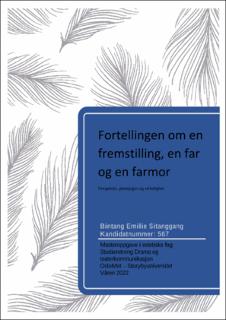| dc.contributor.advisor | Eeg-Tverbakk, Camilla | |
| dc.contributor.author | Sitanggang, Bintang Emilie | |
| dc.contributor.editor | Dahlsveen, Heidi | |
| dc.date.accessioned | 2022-09-01T09:31:20Z | |
| dc.date.available | 2022-09-01T09:31:20Z | |
| dc.date.issued | 2022 | |
| dc.identifier.uri | https://hdl.handle.net/11250/3015069 | |
| dc.description.abstract | I dette masterprosjektet har jeg undersøkt hvordan utarbeidelsen og gjennomføringen av en deltakende fortellerforestilling kan belyse narrative strukturer og den performative virkningen de kan ha. Jeg ønsket hovedsakelig å undersøke de personlige fortellingene vi forteller om oss selv og andre, og se hva disse bringer med seg inn i et fellesskap. Videre ønsket jeg å se på hvilken rolle fortellinger spiller inn på vår virkelighetsoppfatning og på hvilken måte disse strukturene påvirker de ulike virkelighetsoppfatningen som skapes. Utforskningsprosessen har vært praksisledet hvor grunnlaget ble lagt gjennom fortellerforestillingen Sulten på fortellinger. Fortellerforestillingen ble gjennomført sammen med tre ulike grupper, og besto av en gresk myte, personlige fortellinger og deltakende øvelser og opplevelser. Datainnsamlingen baserer seg på forskerens refleksjoner gjennom hele prosessen og deltakernes refleksjoner fra fortellerforestillingen. Refleksjonene settes inn i en større sammenheng og diskuteres opp mot teori knyttet til muntlig fortellerkunst, narratologi og performativitet.
Ved å forstå en muntlig fortellerprosess gjennom et diskursnivå og et fortellingnivå kan man tydeligere se strukturene i en slik prosess. På diskursnivået vil for eksempel fortelleren ta valg som består av blant annet perspektivtaking, ordvalg, fravalg og den velger hvilke elementer som skal fokuseres på. Dette er narrative strukturer som er til stede i enhver muntlig fortellerprosess (bevisst og ubevisst), og disse vil påvirke hvilken virkelighetsoppfatning fortellingen skaper. Videre er en viktig struktur det mulighetsrommet en muntlig fortellerprosess alltid innehar, hvor både fortellingens fleksibilitet og tolkningsrom spiller en viktig rolle. Forteller, fortelling og lytter vil gjensidig påvirke hverandre, og fortellingen vil endres i møte med lytteren. De som lytter vil også tolke og forstå fortellingen ulikt, og derav vil det også skapes ulike virkelighetsoppfatninger. | en_US |
| dc.description.abstract | In this master thesis, I have examined how the preparation and execution of a participating oral storytelling performance can shed light on narrative structures and the performative effect they can have. I mainly wanted to examine the personal stories we tell about ourselves and others and see what these stories can bring into a community. Furthermore, I wanted to look at what role narratives play in our perception of reality and in what way these structures affect the various perceptions of reality that are created. The research process has been practice-led, and the storytelling performance Hunger for stories laid the foundation for the exploration. The storytelling performance was carried out together with three different groups, and consisted of a Greek myth, personal stories and participatory exercises and experiences. The data collection is based on the researcher's reflections throughout the process and the participants' reflections from the storytelling performance. These reflections are viewed in a larger context and discussed in relation to theory about oral storytelling, narratology, and performativity.
By understanding an oral storytelling process through a discourse level and a narrative level, one can more clearly see the structures of such a process. At the discourse level, for example, the storyteller will make choices that consist of, among other things, a point of view, selection of words, exclusion, and which elements that will be in focus. These are narrative structures that are present in any oral storytelling process (consciously and unconsciously), and that will affect the perception of reality that the narrative creates. Furthermore, an important structure is the gaps that an oral storytelling process always has, where both the flexibility of the narrative and the opening for interpretation play an important role. The storyteller, the story and the listener will mutually influence each other, and the story will change as it meets the listener. Listeners will also interpret and understand the story individually, and therefore create different perceptions of reality. | en_US |
| dc.language.iso | nob | en_US |
| dc.publisher | OsloMet - storbyuniversitetet | en_US |
| dc.relation.ispartofseries | MEST;2022 | |
| dc.title | Fortellingen om en fremstilling, en far og en farmor. Perspektiv, persepsjon og virkelighet | en_US |
| dc.type | Master thesis | en_US |
| dc.description.version | publishedVersion | en_US |
